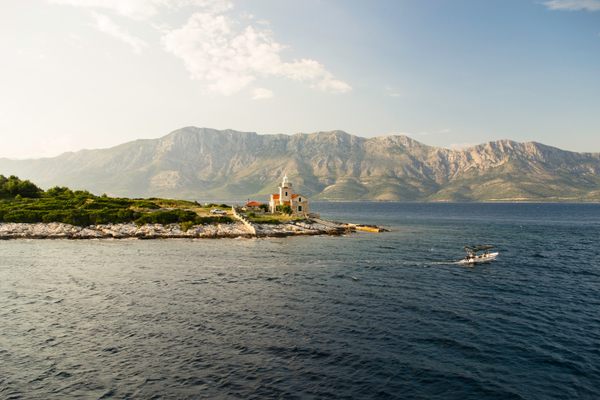How Algae Revealed Ancient Earthquakes in Croatia
Rocky algal rims offer new evidence of Croatia’s seismic past.
This article is from Hakai Magazine, an online publication about science and society in coastal ecosystems. Read more stories like this at hakaimagazine.com.
In 1667, an apocalyptic earthquake almost destroyed Dubrovnik, one of the most beautiful medieval cities in the Mediterranean. Then the center of an independent republic, the city—on the eastern coast of the Adriatic Sea—was a busy seafaring hub and home to more than 30,000 people. The shaking flattened buildings, split cracks in the Earth, and sent massive stones tumbling from the nearby foothills. Witness accounts tell of the tsunami that followed and the wildfires that blazed for days on end. In all, historical records claim 3,000 people died in the multifaceted disaster.
Several centuries of relative tectonic peace later, Dubrovnik—now a city in Croatia—is one of the most popular tourist spots in Europe, hosting more than 1.2 million visitors each year. But, as in any area with a destructive seismic history, one question always remains: What are the odds of the next big one hitting sometime soon?
While scientists can’t predict when a major earthquake will strike, having more precise data about historical disasters can improve their estimations. Yet tracking down reliable proof of ancient earthquakes can be difficult. Fortunately, geomorphologist Sanja Faivre and her team at the University of Zagreb in Croatia have developed a new technique for sleuthing out ancient earthquakes, and it’s one that relies on a most unexpected ally: algae.
Lithophyllum byssoides, a red coralline algae commonly found in the Mediterranean, incorporates calcium carbonate into its tissue. Over long periods, these algae can grow together to produce a rocky structure known as an algal rim. As Faivre explains, algal rims tend to develop when the sea level stays stable or slowly rises over a few hundred years. Algal rims build up layer by layer, making them a useful indicator of historical changes in sea level. But they can also do something more. In a new study, Faivre and her colleagues show that algal rims can also help identify historical earthquakes.
Faivre says they made their discovery almost by accident after spending more than a decade studying sea level change along the Croatian coastline. It was during this process of analyzing the algal rims that they found something truly exciting.
“At many places, we saw algal rims above the sea surface. We knew this probably means only one thing—evidence of a large earthquake,” she says. The key is that, as occurred in Dubrovnik, earthquakes that hit near the shore can cause the local sea level to change suddenly and dramatically. The strong uplift pushes existing algal rims well above sea level while new, younger rims develop below. Comparing the ages of the two can indicate when the earthquake hit.
Scientists first proposed using L. byssoides as an indicator of past sea level change in the 1980s, but confirming this in practice required solving a daunting challenge. In their previous work, Faivre and her colleagues hunted down several algal rims around the Adriatic coast. To figure out how old they were, the scientists used radiocarbon dating. But there was a hitch: radiocarbon age estimates of marine species tend to be distorted compared with terrestrial samples. This is called the marine reservoir effect, and the extent to which it affects dating estimates can even depend on the species being looked at. To that end, Faivre needed to learn how big this error would be for L. byssoides in particular. And because nuclear weapon testing in the mid-20th century distorted the world’s concentration of radiocarbon, she needed samples of the algae that pre-date the atomic age.

Eventually, Faivre sourced old samples of L. byssoides from museums across Europe. “It wasn’t easy to get them,” she says, because the samples would have to be destroyed during the analysis. But the ordeal gave the scientists what they needed to use radiocarbon dating of L. byssoides to track changes in the Mediterranean’s sea level over hundreds of years.
With their method set, Faivre and her team went on to show that not only could their algal rim analysis confirm the well-documented 1667 earthquake that devastated Dubrovnik, it also revealed evidence of earlier and lesser-known disasters.
“Our data confirmed strong earthquakes vaguely mentioned in literature from 1395 and 1520,” Faivre says. They also saw signs of several earthquakes that hit the region between the fourth and sixth centuries CE.
For seismologists, this kind of evidence is hugely valuable. Until recently, with the development of this and other proxy measures, knowledge of ancient earthquakes has mostly relied on scarce descriptions in historical notes.
“Now we know that strong earthquakes in this area happened slightly more often than we thought,” says Josip Stipčević, a seismologist at the University of Zagreb who was not involved in Faivre’s recent research. Every new piece of information about the incidence and intensity of historical earthquakes, he adds, helps us be more prepared for future disasters.




















Follow us on Twitter to get the latest on the world's hidden wonders.
Like us on Facebook to get the latest on the world's hidden wonders.
Follow us on Twitter Like us on Facebook